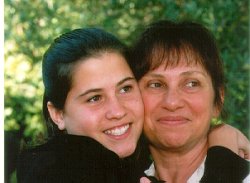(Wendy Lichtman has given us her permission to run her article that appeared in the Washington Post, Sunday, November 22, 1998, page W15. Wendy resides in North California.)

Raising her daughter, she discovered the differences between the world of the hearing and the world of the deaf. She also found bridges between them.
We had 19 people coming for Thanksgiving last year and no matter how we juggled the plates and chairs, my 14-year-old daughter, Bekah, and I were able to squeeze only 18 places at our rented table. Bekah, who is deaf and uses sign language to communicate, stood holding the extra plate. “You know,” she told me, “I don’t need to sit here. I’m not really going to understand what’s happening anyway.” Then she looked at my face, which must have shown my feelings, and signed, “No offense, Mom.”
I wasn’t offended. I was, however, aching, because I knew just why she felt that way. When the kids were younger, they would all eat quickly and run off to play, and Bekah could be included in the games without much difficulty. But now they are all teenagers and young adults and they don’t leave the table




